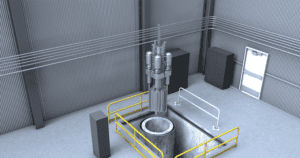
Negotiating contracts is a process that requires preparation and communication, as all parties work toward a mutually beneficial relationship. It’s particularly true for electric utilities, groups with multiple stakeholders in their projects. That includes the utilities themselves, their shareholders or other investors, and of course their customers.
Laura Fraher, partner at Barclay Damon, recently provided POWER with insight into the process. Fraher is co-chair of Barclay Damon’s Power & Energy Construction Practice Area and has extensive experience drafting, negotiating, and providing strategic advice regarding construction contracts for large-scale projects, including commercial, residential, and engineering, procurement, and construction (EPC) contracts for power plant and industrial facility projects.
POWER: What are the various types/structures for contracts in this area (examples could include power purchase agreements, mergers and acquisitions, etc.)?
Fraher: As it relates to construction, the contract model most typically employed for large power projects is the EPC Contract. This contract model essentially establishes a ‘one-stop shop’ for the owner entity, with a single EPC contractor fully responsible for the complete scope of engineering (design of entire power plant), procurement (purchase, installation, and performance of all equipment), and construction (construction of the plant) of the entire project. Traditionally, most EPC contracts are lump- sum contracts.

An alternative delivery model we are seeing more of lately, particularly in the context of very large, complex projects, is the EPC Manager (EPCM model). In this scenario, the owner entity enters into an EPCM contract with a construction manager, who typically is fully responsible for the complete scope of engineering, but rather than performing the procurement and construction phases, instead acts as construction manager for those phases while the owner entity separately contracts with construction contractor(s) and/or supplier(s) for procurement and construction.
An alternative pricing model we are seeing more of lately in the EPC context is the Guaranteed Maximum Price (GMP) model in place of the lump sum EPC contract. This is a cost-reimbursable, not-to-exceed model and typically includes an open-book process with required supporting documentation.
For the ongoing physical needs of the plant after construction is complete, Operations and maintenance (O&M) or Long-Term Services Agreements (LTSA) are typically used.
POWER: What are the most important factors (legal and otherwise) for electric utilities and/or power generators to consider when negotiating contracts (whether for power supply, construction, etc.)?
Fraher: The contract is your key tool for mitigating risk and minimizing the potential for disputes during the construction of a power project, and therefore the most important thing to keep in mind when negotiating contracts is the importance of clarity and specificity of language. Thus, it is generally preferable to address and resolve any potential ambiguities during the contract negotiation, including by discussing how the contract language would apply to concrete hypothetical scenarios that are likely to occur, rather than to accept potentially ambiguous language and rely on your ability to persuade a fact finder that your interpretation of that language is correct if a dispute arises later.
For more insight into how power companies negotiate contracts, read “Procuring Power: Experts Discuss Contract Complexities,” part of POWER’s Power Contractors Special Report.
When negotiating your construction contract, keep in mind that being able to generate power on time is your end goal, and therefore you should pay particular attention to schedule. It is important to agree on a realistic schedule. While you should never agree to a schedule that extends longer than your commercial needs, an unrealistically short schedule brings a high likelihood of disputes, claims, and project extensions that create uncertainty and often end up being more costly and creating longer delays than would have been realized if you had agreed to a realistic schedule in the first place. It is also important to negotiate meaningful and legally enforceable penalties for failing to adhere to the agreed upon schedule.
POWER: How should electric utilities and/or power generators protect themselves from liability in contract language?
Fraher: As it relates to construction contracts, there are many key contractual terms that a utility or power generator should include to protect themselves from liability and to allocate risks. Some of the most important are the warranty provision; indemnification provision; dispute resolution provision; schedule provisions and corresponding provisions providing for remedies, including liquidated damages; standards of performance, performance guarantees, and corresponding remedy provisions; changes provisions; and provisions regarding suspension, termination, and default.
One of the most significant contract provisions for liability and risk allocation is the warranty provision. Owners should insist that the contractor provide a robust warranty that guarantees its entire scope of work and requires, at the owner’s option, that the contractor repair or replace defective work for a significant period of time after completion of construction. However, rather than agree to a warranty that provides for exclusive remedies in the event a contractor performs defective work, owners should also seek to impose specific performance guarantees with corresponding specified remedies for failure to meet such guarantees and also seek to retain common law remedies for breach of contract and negligence.
Dispute resolution provisions are sometimes overlooked because they do not address the substantive rights and obligations of the contract parties. But a well-crafted dispute resolution provision can be an important tool for avoiding costly, protracted disputes and defining the appropriate parameters for the resolution of those that cannot be avoided.
First, the steps required for dispute resolution are important. For large and complex projects, we often recommend a mandatory three-step dispute resolution process that first requires negotiation between key, high-level decision makers for the parties, followed by non-binding mediation with a neutral, knowledgeable mediator, and only then would the parties pursue binding dispute resolution. For smaller projects or lower-dollar value disputes, it may make sense to eliminate the first step in this process.
The key is to require that the parties engage in a meaningful attempt to resolve their disputes before resorting to costly litigation or arbitration while not creating an unnecessarily cumbersome process that is warranted for the scope of the dispute at issue. Second, the contract should define who will be the decision-maker if you do end up in binding dispute resolution. The parties should select whether disputes will be submitted to a court or arbitration panel; if to a court, the contract should state the specific venue and whether the dispute will be decided by a judge or a jury, and if to an arbitration panel, the geographic location and number and qualification of arbitrators should be defined.
POWER: Could you provide details about a contract negotiation you’re familiar with?
Fraher: I am currently working on negotiating an EPC contract on a significant LNG (liquefied natural gas) vaporizer project. A key issue that has arisen is how to address potential material escalation and, specifically, the potential impacts of tariffs on the project. We are focusing on clarifying contract language that was not drafted to specifically address tariffs, but nevertheless may be applicable, including change in law, force majeure, and tax provisions as well as negotiating and drafting new provisions specifically tailored to address these issues.
—Darrell Proctor is a senior editor for POWER.










